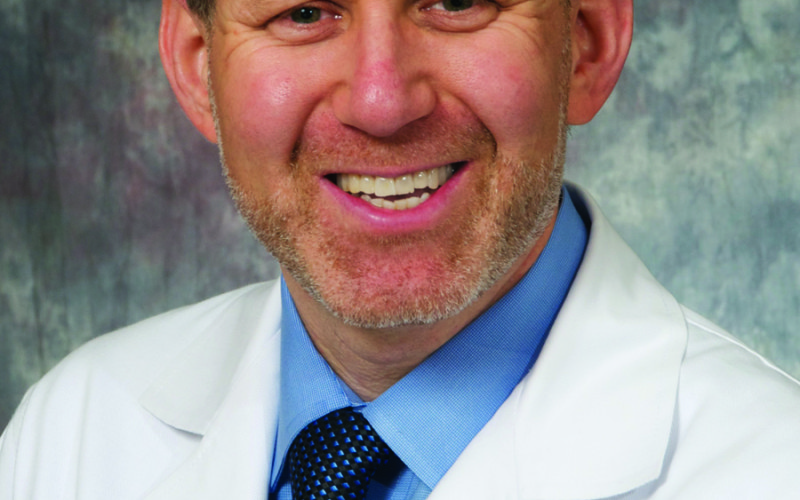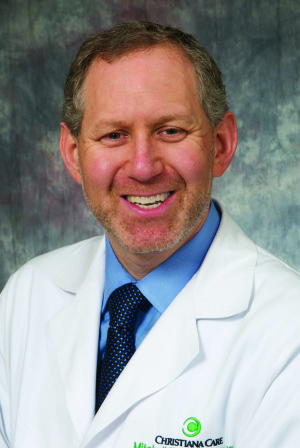Rehabilitation program for electric heart pump patients launched at Wilmington Hospital


Imagine awaking one day, your life newly reliant on an electric heart pump that must never lose power. Now imagine having to leave your familiar medical team at Christiana Care to travel to a rehabilitation facility in another state to learn the special skills you will need to live the rest of your life.
Until recently, that was the reality for patients with heart failure who had a left-ventricular-assist device (LVAD) implanted, either as a bridge to a heart transplant or as a destination therapy, if a new heart is not an option.
In February, the Center for Rehabilitation at Wilmington Hospital welcomed its first LVAD patient, following months of intensive staff training on the device and the particular needs of those living with it.
“It’s a huge deal,” said Mitchell Saltzberg, M.D., FACC, FAHA, medical director of the Heart Failure Program. He and his partner Meenakshi Bhalla, M.D. are the only two cardiologists in Delaware certified by the American Board of Internal Medicine in advanced heart failure and transplant cardiology. “Having a patient be able to stay in Delaware for their inpatient rehabilitation allows members of our team access to the patient, and at the same time it allows the patient to stay closer to their family. It gives us a greater comfort level.”
Susan Felicia, FNP-C, coordinator and nurse practitioner for the VAD/Structural Heart Program, orchestrated the training for the rehabilitation staff that paved the way for the first LVAD admission.
“It’s tough to ask the family to go to Center City Philadelphia or someplace else out of state when they’re still working and living their lives,” Felicia said. “In the past, patients have been separated from their families while they were going through an inpatient rehabilitation program. For success, you really need their physical and emotional well-being to be on the same page.”
The new service was a godsend for Linda Leedom, a Newark resident who this spring became the first LVAD patient admitted to the Center for Rehabilitation at Wilmington Hospital. Not an ideal candidate for a new heart, Leedom needed to learn such technical skills as charging and changing her batteries as well as simple behavioral modifications, like sitting in the rear seat of a car, away from the airbag, and placing the shoulder seat strap behind her. She was impressed with the expert care of her doctors and the respect they showed in partnering with her to manage her treatment.
But as pain from the operation set in, so did the fear of the unknown — especially when she found she could walk only a few feet after entering rehab. But with her team’s encouragement and personalization of her therapy regimen, Leedom was strolling around the facility in just a few weeks and encouraging newcomers that they, too, could improve.
“They couldn’t do enough for me. They were all fabulous — they’re like family,” Leedom said of the rehab staff, who continue to reach out to her with helpful tips for living with her new device.
Leedom’s care is in excellent hands. Christiana Care’s is the only heart failure program in Delaware awarded the Joint Commission certification in heart failure. The program provides comprehensive services to patients with heart failure, with access to care by physicians, nurse practitioners, nutritionists, behavioral health specialists and social workers — all who have expertise in the care of heart failure patients. The Heart Failure Program has offices in New Castle and Sussex counties.
Meanwhile, the rehabilitation center is fully accredited by the Commission on Accreditation of Rehabilitation Facilities (CARF). It is one of fewer than 100 centers in the country to hold CARF certification for its brain injury, stroke and amputation programs, according to Jennifer Thomas, MS, CCC-SLP, director of Rehabilitation Services. Its strategic location within Wilmington Hospital also gives it an advantage over a freestanding facility, she said, enabling it to seamlessly address urgent or consultative needs.
“For example, if we need the expertise of a cardiologist, they’re here in the building and can respond in minutes — we just have to call,” she said. “One of the things we really try to highlight about our services is we have that continuum of care to offer, from inpatient to rehab to outpatient.”
Staff physical therapist Rebecca Beeby, PT, DPT, agrees.
“Patients have the continuous care of the providers they will meet before surgery, during their hospitalization and in recovery,” Beeby said. “And, the patient is here — I have her direct line and don’t have to worry about going through someone else first. From a team member’s perspective, having that support is the best.”
Even when there are no LVAD patients receiving care at the Center for Rehabilitation at Wilmington Hospital, staff training on their care will continue with new employees and is expected to become part of the annual critical skills refresher, said Felisha Alderson, MSN, RN, CRNN, nurse manager.
“There are things you don’t see all the time but that you need to know,” Alderson said. “Not every patient who has an LVAD is going to need rehab, but the ones that do, we want them to stay local. It’s a great service we offer to the community, and that’s what we’re trying to do — take care of the community.”
Leedom was so pleased with her rehabilitation experience at that she’s volunteering as a member of the center’s Patient-and Family-Centered Care Council, which advises on future projects or improvements.
“I told Dr. Saltzberg it was like that saying — don’t repay kindness, pass it on,” Leedom said. “I don’t know how I could ever repay this kindness. They’ve given me back my life.”